International HRM Reflective Learning Report - Task 1 & 2
VerifiedAdded on 2023/01/18
|20
|5319
|42
Report
AI Summary
This report presents a reflective learning analysis of International Human Resource Management (IHRM), focusing on Task 1 and Task 2 as outlined in the assignment brief. The report begins with an introduction to globalization and its impact on IHRM, emphasizing the complexities and challenges faced by organizations operating internationally. Task 1 critically compares IHRM concepts and theories, including definitions, scope, purpose, objectives, practices, and the factors that influence IHRM. It also differentiates between domestic and international HRM, examines the IHRM model, and explores environmental and cultural differences, convergence and divergence, and expatriate management. Task 2 involves opening statements and group discussions, demonstrating an understanding of intercultural management and comparison of international management and HR practices. The report incorporates research beyond the lecture materials, analyzes the implications for international organizations, and provides evidence of reflection and personal learning, aligning with the assignment criteria.
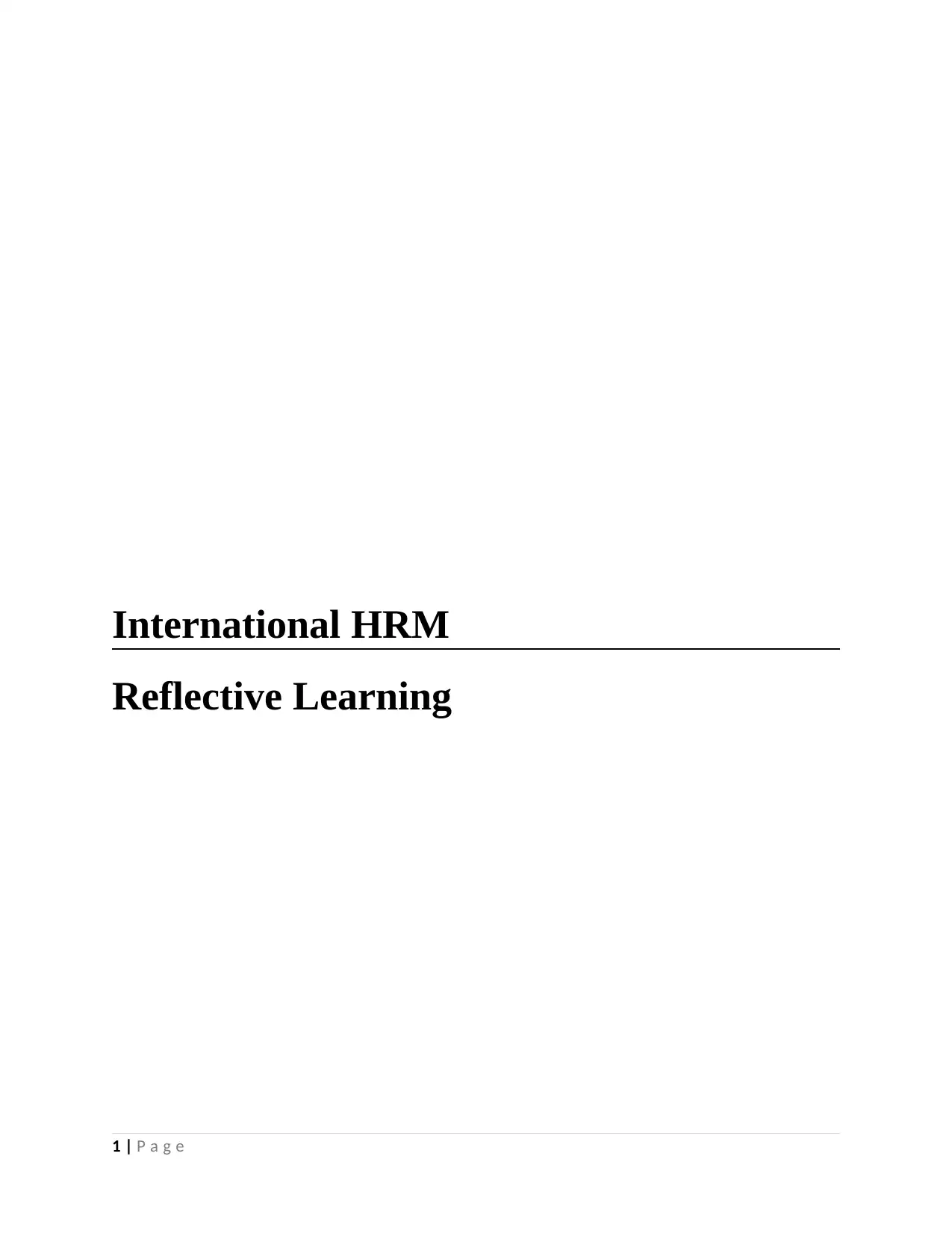
International HRM
Reflective Learning
1 | P a g e
Reflective Learning
1 | P a g e
Paraphrase This Document
Need a fresh take? Get an instant paraphrase of this document with our AI Paraphraser
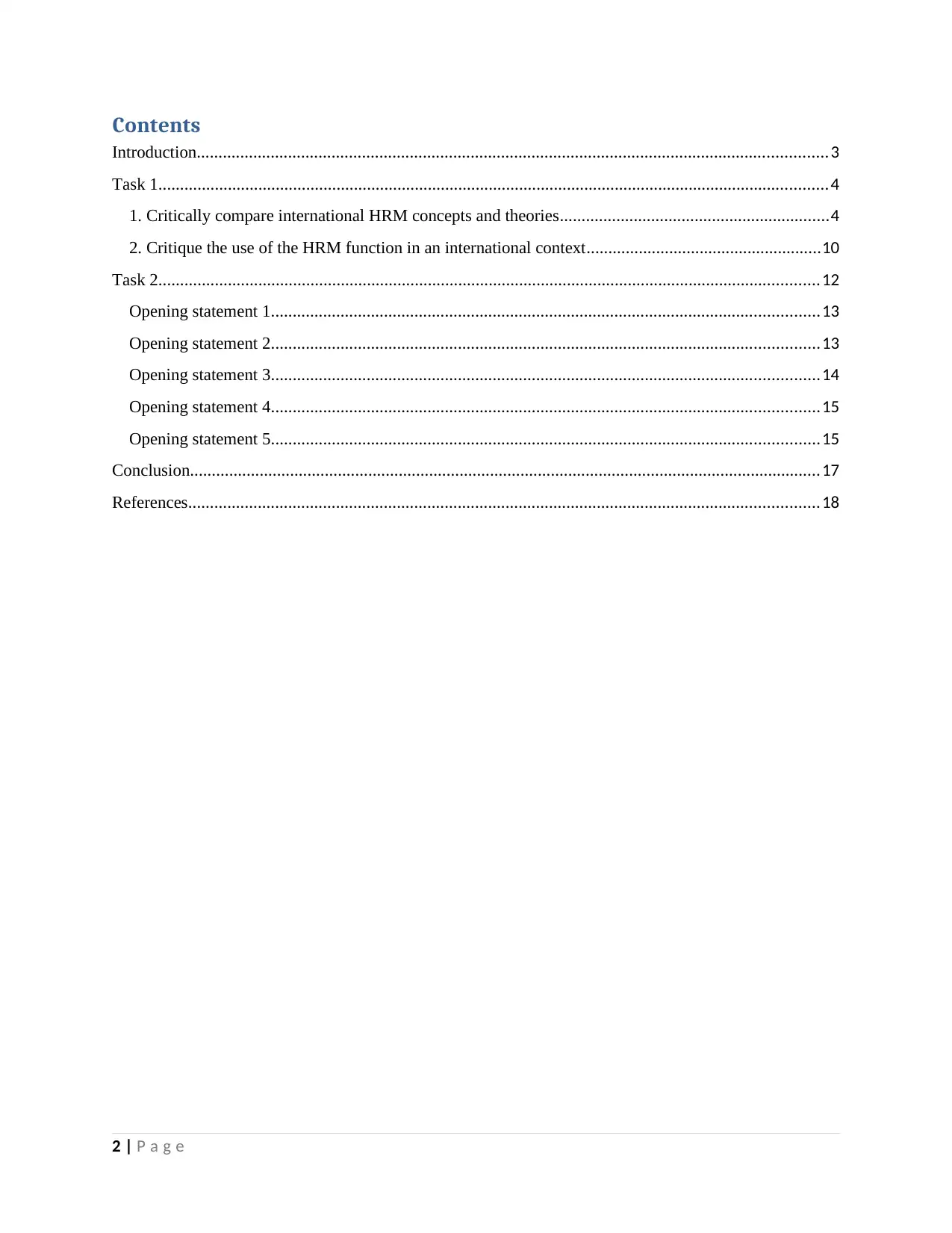
Contents
Introduction.................................................................................................................................................3
Task 1..........................................................................................................................................................4
1. Critically compare international HRM concepts and theories..............................................................4
2. Critique the use of the HRM function in an international context......................................................10
Task 2........................................................................................................................................................12
Opening statement 1..............................................................................................................................13
Opening statement 2..............................................................................................................................13
Opening statement 3..............................................................................................................................14
Opening statement 4..............................................................................................................................15
Opening statement 5..............................................................................................................................15
Conclusion.................................................................................................................................................17
References.................................................................................................................................................18
2 | P a g e
Introduction.................................................................................................................................................3
Task 1..........................................................................................................................................................4
1. Critically compare international HRM concepts and theories..............................................................4
2. Critique the use of the HRM function in an international context......................................................10
Task 2........................................................................................................................................................12
Opening statement 1..............................................................................................................................13
Opening statement 2..............................................................................................................................13
Opening statement 3..............................................................................................................................14
Opening statement 4..............................................................................................................................15
Opening statement 5..............................................................................................................................15
Conclusion.................................................................................................................................................17
References.................................................................................................................................................18
2 | P a g e
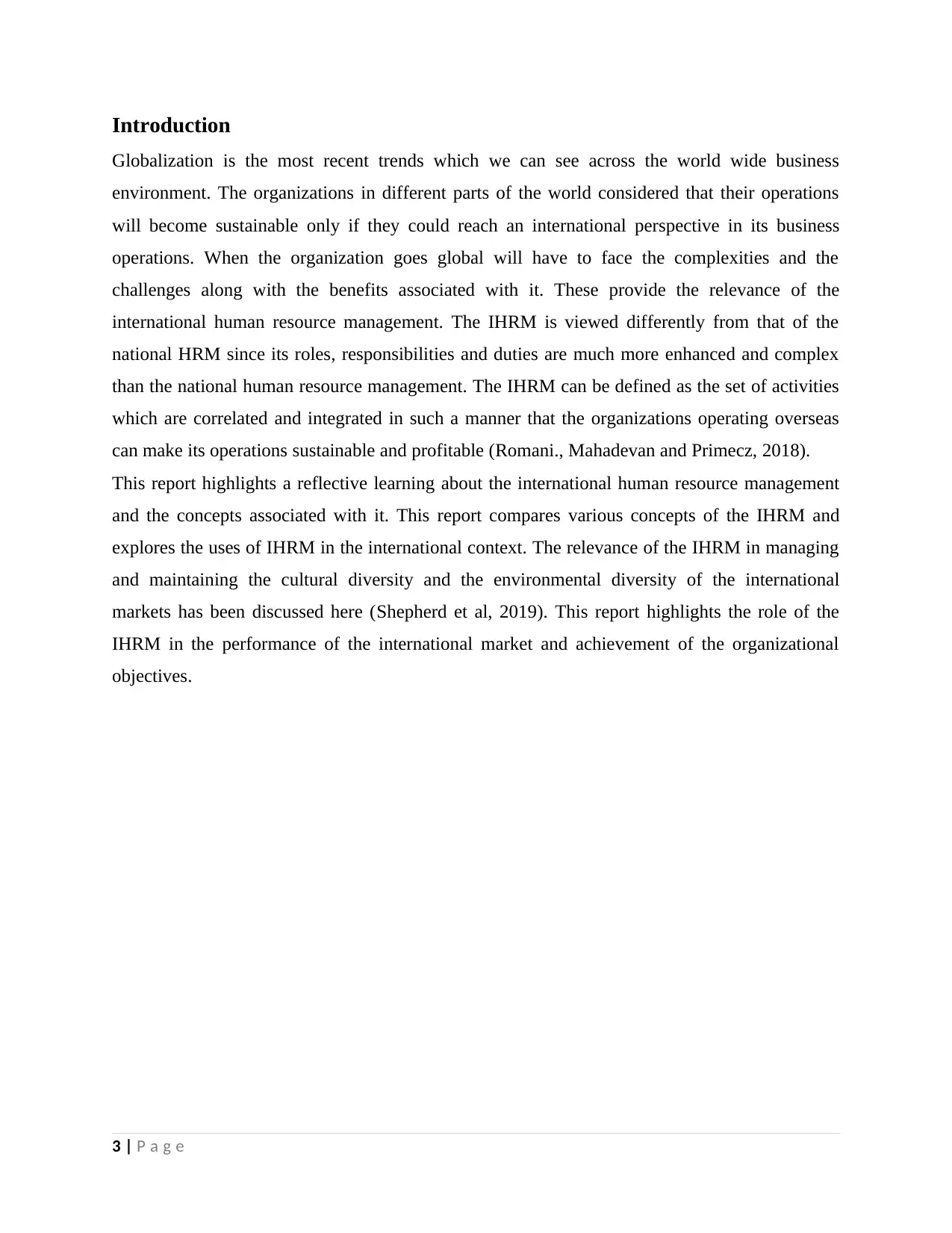
Introduction
Globalization is the most recent trends which we can see across the world wide business
environment. The organizations in different parts of the world considered that their operations
will become sustainable only if they could reach an international perspective in its business
operations. When the organization goes global will have to face the complexities and the
challenges along with the benefits associated with it. These provide the relevance of the
international human resource management. The IHRM is viewed differently from that of the
national HRM since its roles, responsibilities and duties are much more enhanced and complex
than the national human resource management. The IHRM can be defined as the set of activities
which are correlated and integrated in such a manner that the organizations operating overseas
can make its operations sustainable and profitable (Romani., Mahadevan and Primecz, 2018).
This report highlights a reflective learning about the international human resource management
and the concepts associated with it. This report compares various concepts of the IHRM and
explores the uses of IHRM in the international context. The relevance of the IHRM in managing
and maintaining the cultural diversity and the environmental diversity of the international
markets has been discussed here (Shepherd et al, 2019). This report highlights the role of the
IHRM in the performance of the international market and achievement of the organizational
objectives.
3 | P a g e
Globalization is the most recent trends which we can see across the world wide business
environment. The organizations in different parts of the world considered that their operations
will become sustainable only if they could reach an international perspective in its business
operations. When the organization goes global will have to face the complexities and the
challenges along with the benefits associated with it. These provide the relevance of the
international human resource management. The IHRM is viewed differently from that of the
national HRM since its roles, responsibilities and duties are much more enhanced and complex
than the national human resource management. The IHRM can be defined as the set of activities
which are correlated and integrated in such a manner that the organizations operating overseas
can make its operations sustainable and profitable (Romani., Mahadevan and Primecz, 2018).
This report highlights a reflective learning about the international human resource management
and the concepts associated with it. This report compares various concepts of the IHRM and
explores the uses of IHRM in the international context. The relevance of the IHRM in managing
and maintaining the cultural diversity and the environmental diversity of the international
markets has been discussed here (Shepherd et al, 2019). This report highlights the role of the
IHRM in the performance of the international market and achievement of the organizational
objectives.
3 | P a g e
⊘ This is a preview!⊘
Do you want full access?
Subscribe today to unlock all pages.

Trusted by 1+ million students worldwide
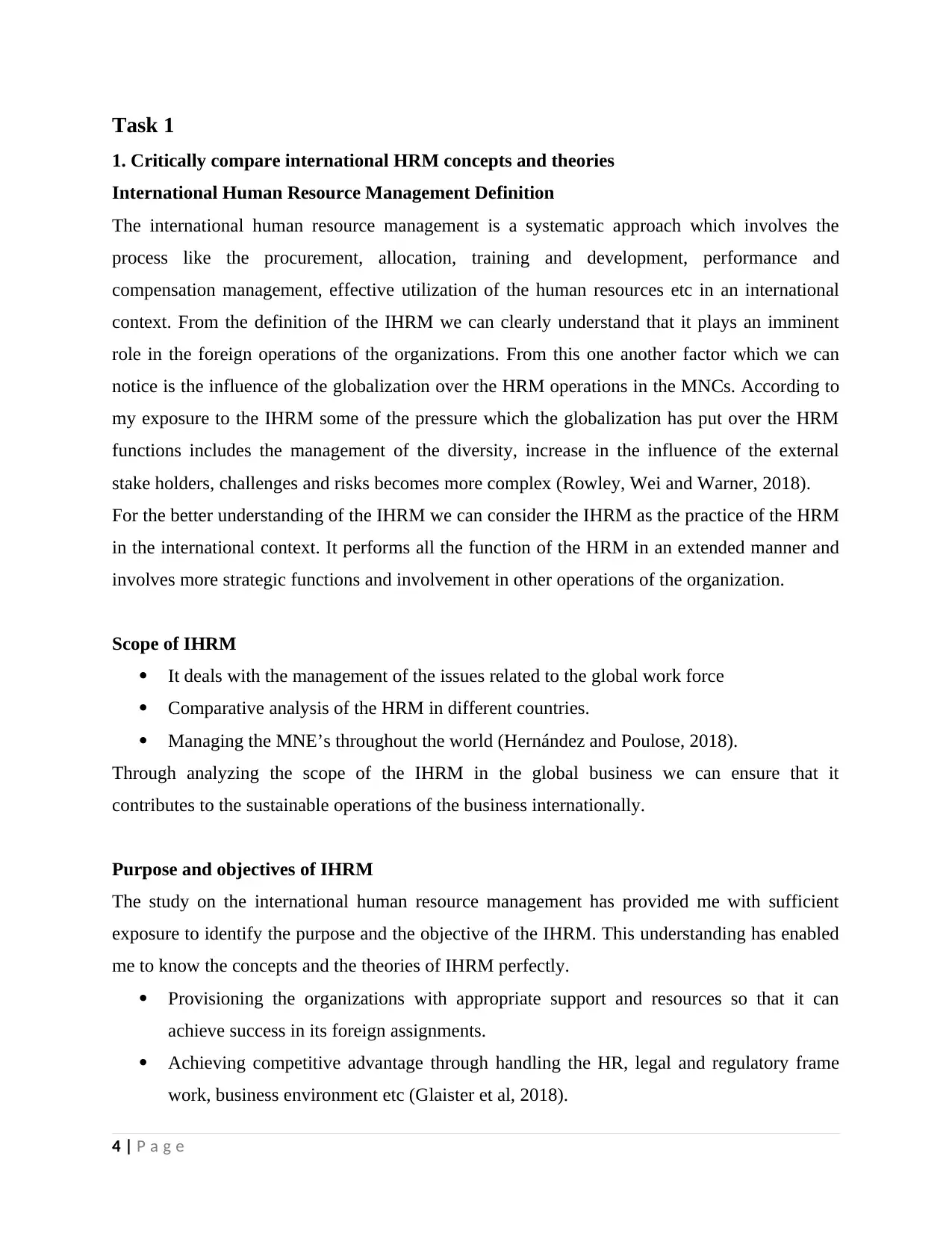
Task 1
1. Critically compare international HRM concepts and theories
International Human Resource Management Definition
The international human resource management is a systematic approach which involves the
process like the procurement, allocation, training and development, performance and
compensation management, effective utilization of the human resources etc in an international
context. From the definition of the IHRM we can clearly understand that it plays an imminent
role in the foreign operations of the organizations. From this one another factor which we can
notice is the influence of the globalization over the HRM operations in the MNCs. According to
my exposure to the IHRM some of the pressure which the globalization has put over the HRM
functions includes the management of the diversity, increase in the influence of the external
stake holders, challenges and risks becomes more complex (Rowley, Wei and Warner, 2018).
For the better understanding of the IHRM we can consider the IHRM as the practice of the HRM
in the international context. It performs all the function of the HRM in an extended manner and
involves more strategic functions and involvement in other operations of the organization.
Scope of IHRM
It deals with the management of the issues related to the global work force
Comparative analysis of the HRM in different countries.
Managing the MNE’s throughout the world (Hernández and Poulose, 2018).
Through analyzing the scope of the IHRM in the global business we can ensure that it
contributes to the sustainable operations of the business internationally.
Purpose and objectives of IHRM
The study on the international human resource management has provided me with sufficient
exposure to identify the purpose and the objective of the IHRM. This understanding has enabled
me to know the concepts and the theories of IHRM perfectly.
Provisioning the organizations with appropriate support and resources so that it can
achieve success in its foreign assignments.
Achieving competitive advantage through handling the HR, legal and regulatory frame
work, business environment etc (Glaister et al, 2018).
4 | P a g e
1. Critically compare international HRM concepts and theories
International Human Resource Management Definition
The international human resource management is a systematic approach which involves the
process like the procurement, allocation, training and development, performance and
compensation management, effective utilization of the human resources etc in an international
context. From the definition of the IHRM we can clearly understand that it plays an imminent
role in the foreign operations of the organizations. From this one another factor which we can
notice is the influence of the globalization over the HRM operations in the MNCs. According to
my exposure to the IHRM some of the pressure which the globalization has put over the HRM
functions includes the management of the diversity, increase in the influence of the external
stake holders, challenges and risks becomes more complex (Rowley, Wei and Warner, 2018).
For the better understanding of the IHRM we can consider the IHRM as the practice of the HRM
in the international context. It performs all the function of the HRM in an extended manner and
involves more strategic functions and involvement in other operations of the organization.
Scope of IHRM
It deals with the management of the issues related to the global work force
Comparative analysis of the HRM in different countries.
Managing the MNE’s throughout the world (Hernández and Poulose, 2018).
Through analyzing the scope of the IHRM in the global business we can ensure that it
contributes to the sustainable operations of the business internationally.
Purpose and objectives of IHRM
The study on the international human resource management has provided me with sufficient
exposure to identify the purpose and the objective of the IHRM. This understanding has enabled
me to know the concepts and the theories of IHRM perfectly.
Provisioning the organizations with appropriate support and resources so that it can
achieve success in its foreign assignments.
Achieving competitive advantage through handling the HR, legal and regulatory frame
work, business environment etc (Glaister et al, 2018).
4 | P a g e
Paraphrase This Document
Need a fresh take? Get an instant paraphrase of this document with our AI Paraphraser
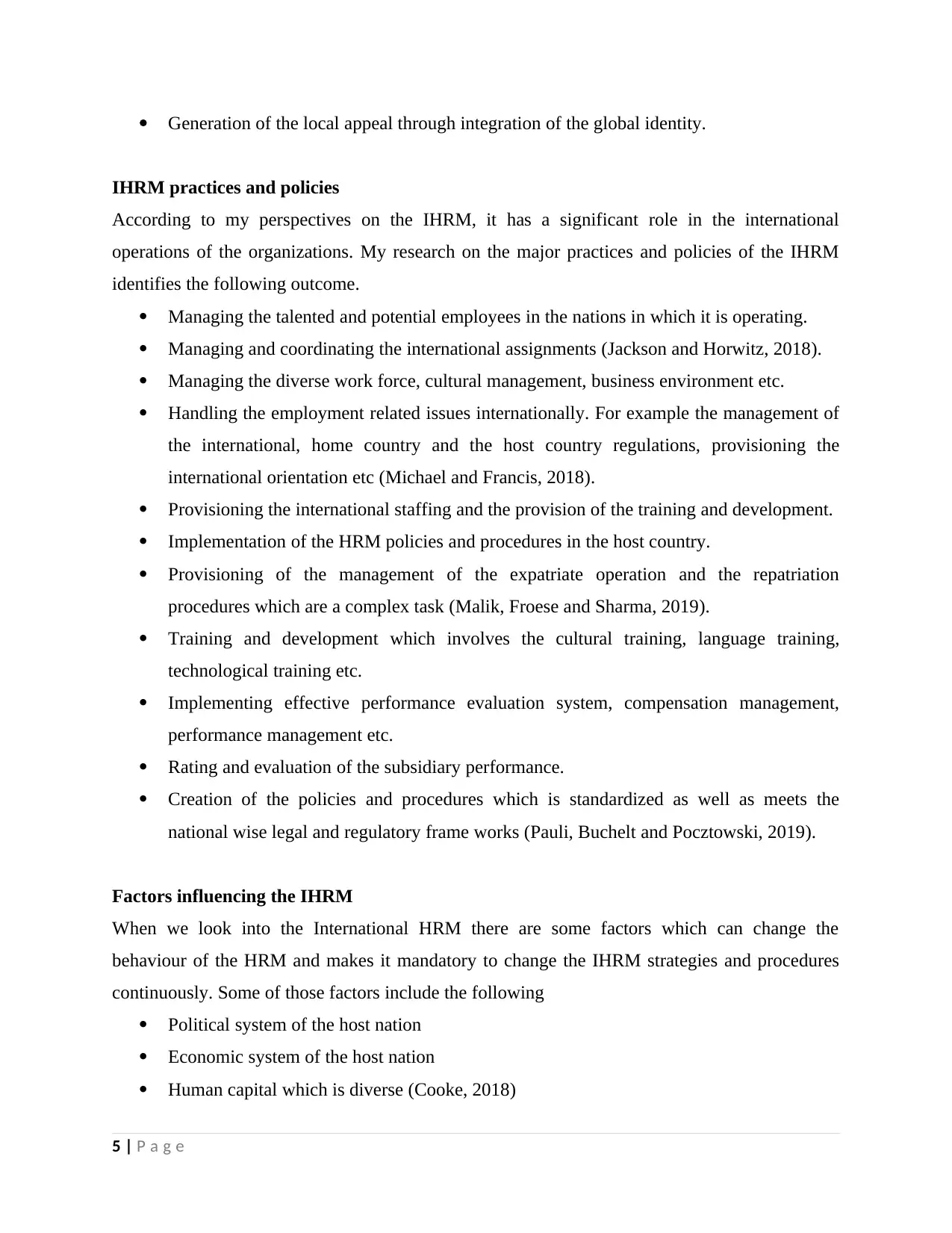
Generation of the local appeal through integration of the global identity.
IHRM practices and policies
According to my perspectives on the IHRM, it has a significant role in the international
operations of the organizations. My research on the major practices and policies of the IHRM
identifies the following outcome.
Managing the talented and potential employees in the nations in which it is operating.
Managing and coordinating the international assignments (Jackson and Horwitz, 2018).
Managing the diverse work force, cultural management, business environment etc.
Handling the employment related issues internationally. For example the management of
the international, home country and the host country regulations, provisioning the
international orientation etc (Michael and Francis, 2018).
Provisioning the international staffing and the provision of the training and development.
Implementation of the HRM policies and procedures in the host country.
Provisioning of the management of the expatriate operation and the repatriation
procedures which are a complex task (Malik, Froese and Sharma, 2019).
Training and development which involves the cultural training, language training,
technological training etc.
Implementing effective performance evaluation system, compensation management,
performance management etc.
Rating and evaluation of the subsidiary performance.
Creation of the policies and procedures which is standardized as well as meets the
national wise legal and regulatory frame works (Pauli, Buchelt and Pocztowski, 2019).
Factors influencing the IHRM
When we look into the International HRM there are some factors which can change the
behaviour of the HRM and makes it mandatory to change the IHRM strategies and procedures
continuously. Some of those factors include the following
Political system of the host nation
Economic system of the host nation
Human capital which is diverse (Cooke, 2018)
5 | P a g e
IHRM practices and policies
According to my perspectives on the IHRM, it has a significant role in the international
operations of the organizations. My research on the major practices and policies of the IHRM
identifies the following outcome.
Managing the talented and potential employees in the nations in which it is operating.
Managing and coordinating the international assignments (Jackson and Horwitz, 2018).
Managing the diverse work force, cultural management, business environment etc.
Handling the employment related issues internationally. For example the management of
the international, home country and the host country regulations, provisioning the
international orientation etc (Michael and Francis, 2018).
Provisioning the international staffing and the provision of the training and development.
Implementation of the HRM policies and procedures in the host country.
Provisioning of the management of the expatriate operation and the repatriation
procedures which are a complex task (Malik, Froese and Sharma, 2019).
Training and development which involves the cultural training, language training,
technological training etc.
Implementing effective performance evaluation system, compensation management,
performance management etc.
Rating and evaluation of the subsidiary performance.
Creation of the policies and procedures which is standardized as well as meets the
national wise legal and regulatory frame works (Pauli, Buchelt and Pocztowski, 2019).
Factors influencing the IHRM
When we look into the International HRM there are some factors which can change the
behaviour of the HRM and makes it mandatory to change the IHRM strategies and procedures
continuously. Some of those factors include the following
Political system of the host nation
Economic system of the host nation
Human capital which is diverse (Cooke, 2018)
5 | P a g e
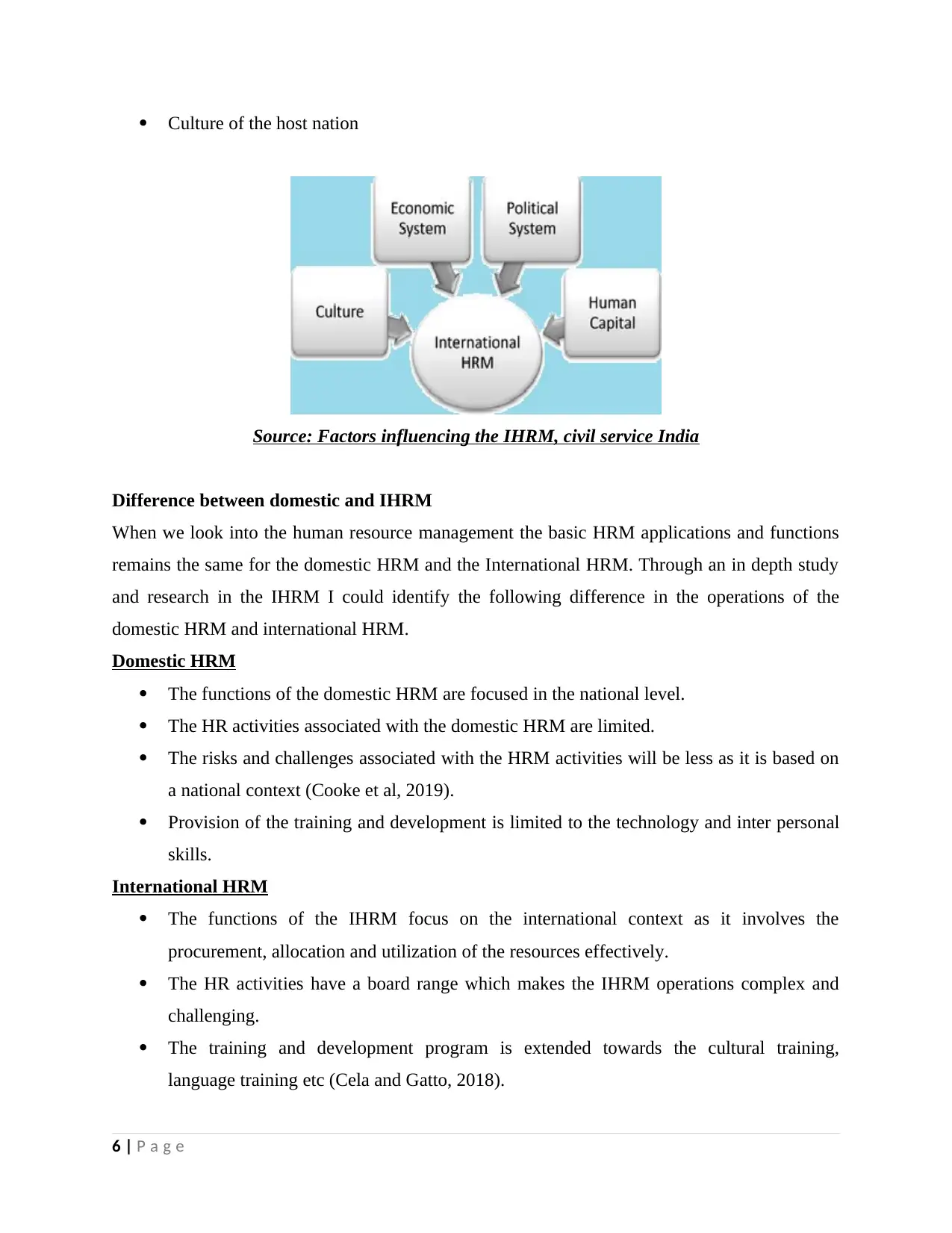
Culture of the host nation
Source: Factors influencing the IHRM, civil service India
Difference between domestic and IHRM
When we look into the human resource management the basic HRM applications and functions
remains the same for the domestic HRM and the International HRM. Through an in depth study
and research in the IHRM I could identify the following difference in the operations of the
domestic HRM and international HRM.
Domestic HRM
The functions of the domestic HRM are focused in the national level.
The HR activities associated with the domestic HRM are limited.
The risks and challenges associated with the HRM activities will be less as it is based on
a national context (Cooke et al, 2019).
Provision of the training and development is limited to the technology and inter personal
skills.
International HRM
The functions of the IHRM focus on the international context as it involves the
procurement, allocation and utilization of the resources effectively.
The HR activities have a board range which makes the IHRM operations complex and
challenging.
The training and development program is extended towards the cultural training,
language training etc (Cela and Gatto, 2018).
6 | P a g e
Source: Factors influencing the IHRM, civil service India
Difference between domestic and IHRM
When we look into the human resource management the basic HRM applications and functions
remains the same for the domestic HRM and the International HRM. Through an in depth study
and research in the IHRM I could identify the following difference in the operations of the
domestic HRM and international HRM.
Domestic HRM
The functions of the domestic HRM are focused in the national level.
The HR activities associated with the domestic HRM are limited.
The risks and challenges associated with the HRM activities will be less as it is based on
a national context (Cooke et al, 2019).
Provision of the training and development is limited to the technology and inter personal
skills.
International HRM
The functions of the IHRM focus on the international context as it involves the
procurement, allocation and utilization of the resources effectively.
The HR activities have a board range which makes the IHRM operations complex and
challenging.
The training and development program is extended towards the cultural training,
language training etc (Cela and Gatto, 2018).
6 | P a g e
⊘ This is a preview!⊘
Do you want full access?
Subscribe today to unlock all pages.

Trusted by 1+ million students worldwide
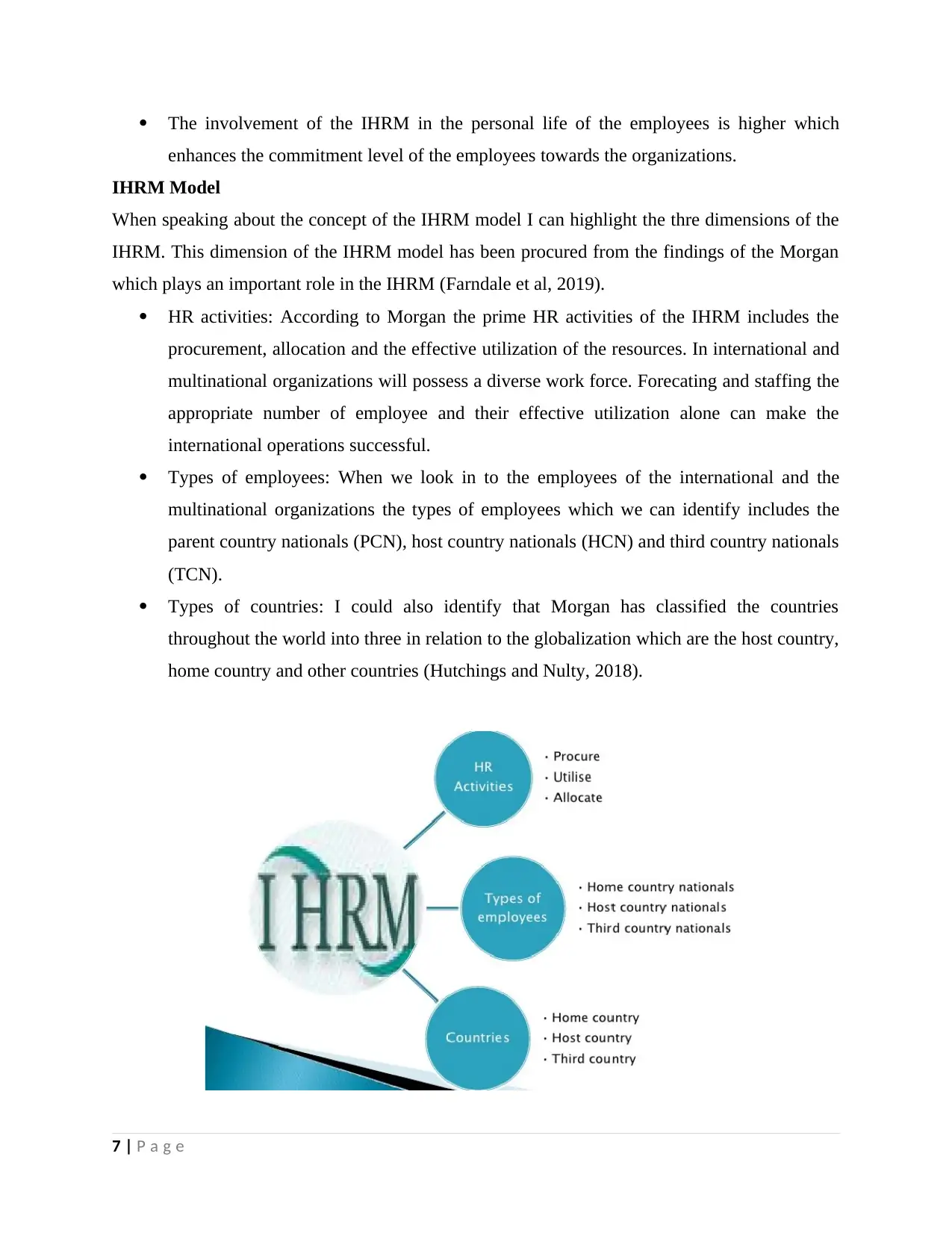
The involvement of the IHRM in the personal life of the employees is higher which
enhances the commitment level of the employees towards the organizations.
IHRM Model
When speaking about the concept of the IHRM model I can highlight the thre dimensions of the
IHRM. This dimension of the IHRM model has been procured from the findings of the Morgan
which plays an important role in the IHRM (Farndale et al, 2019).
HR activities: According to Morgan the prime HR activities of the IHRM includes the
procurement, allocation and the effective utilization of the resources. In international and
multinational organizations will possess a diverse work force. Forecating and staffing the
appropriate number of employee and their effective utilization alone can make the
international operations successful.
Types of employees: When we look in to the employees of the international and the
multinational organizations the types of employees which we can identify includes the
parent country nationals (PCN), host country nationals (HCN) and third country nationals
(TCN).
Types of countries: I could also identify that Morgan has classified the countries
throughout the world into three in relation to the globalization which are the host country,
home country and other countries (Hutchings and Nulty, 2018).
7 | P a g e
enhances the commitment level of the employees towards the organizations.
IHRM Model
When speaking about the concept of the IHRM model I can highlight the thre dimensions of the
IHRM. This dimension of the IHRM model has been procured from the findings of the Morgan
which plays an important role in the IHRM (Farndale et al, 2019).
HR activities: According to Morgan the prime HR activities of the IHRM includes the
procurement, allocation and the effective utilization of the resources. In international and
multinational organizations will possess a diverse work force. Forecating and staffing the
appropriate number of employee and their effective utilization alone can make the
international operations successful.
Types of employees: When we look in to the employees of the international and the
multinational organizations the types of employees which we can identify includes the
parent country nationals (PCN), host country nationals (HCN) and third country nationals
(TCN).
Types of countries: I could also identify that Morgan has classified the countries
throughout the world into three in relation to the globalization which are the host country,
home country and other countries (Hutchings and Nulty, 2018).
7 | P a g e
Paraphrase This Document
Need a fresh take? Get an instant paraphrase of this document with our AI Paraphraser
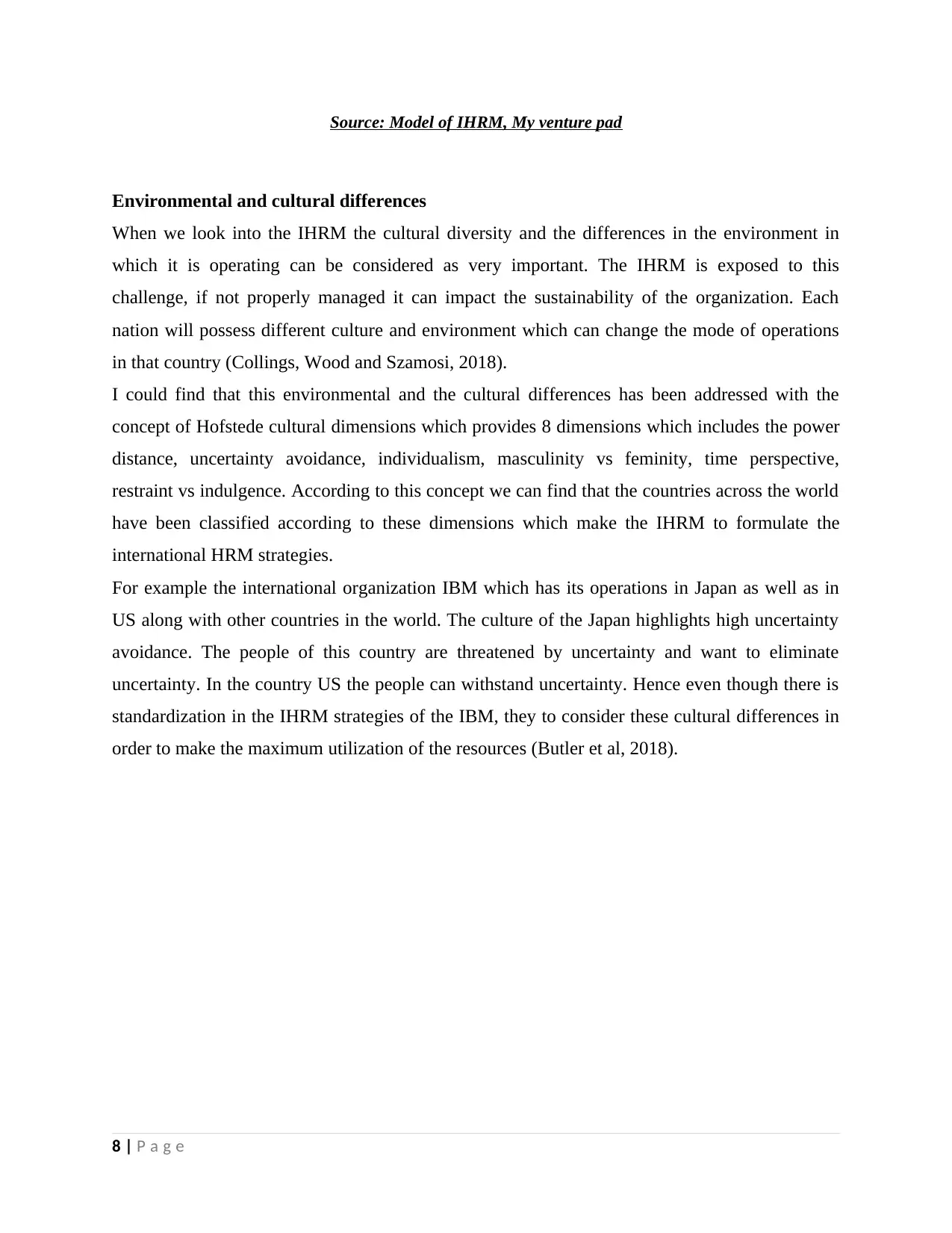
Source: Model of IHRM, My venture pad
Environmental and cultural differences
When we look into the IHRM the cultural diversity and the differences in the environment in
which it is operating can be considered as very important. The IHRM is exposed to this
challenge, if not properly managed it can impact the sustainability of the organization. Each
nation will possess different culture and environment which can change the mode of operations
in that country (Collings, Wood and Szamosi, 2018).
I could find that this environmental and the cultural differences has been addressed with the
concept of Hofstede cultural dimensions which provides 8 dimensions which includes the power
distance, uncertainty avoidance, individualism, masculinity vs feminity, time perspective,
restraint vs indulgence. According to this concept we can find that the countries across the world
have been classified according to these dimensions which make the IHRM to formulate the
international HRM strategies.
For example the international organization IBM which has its operations in Japan as well as in
US along with other countries in the world. The culture of the Japan highlights high uncertainty
avoidance. The people of this country are threatened by uncertainty and want to eliminate
uncertainty. In the country US the people can withstand uncertainty. Hence even though there is
standardization in the IHRM strategies of the IBM, they to consider these cultural differences in
order to make the maximum utilization of the resources (Butler et al, 2018).
8 | P a g e
Environmental and cultural differences
When we look into the IHRM the cultural diversity and the differences in the environment in
which it is operating can be considered as very important. The IHRM is exposed to this
challenge, if not properly managed it can impact the sustainability of the organization. Each
nation will possess different culture and environment which can change the mode of operations
in that country (Collings, Wood and Szamosi, 2018).
I could find that this environmental and the cultural differences has been addressed with the
concept of Hofstede cultural dimensions which provides 8 dimensions which includes the power
distance, uncertainty avoidance, individualism, masculinity vs feminity, time perspective,
restraint vs indulgence. According to this concept we can find that the countries across the world
have been classified according to these dimensions which make the IHRM to formulate the
international HRM strategies.
For example the international organization IBM which has its operations in Japan as well as in
US along with other countries in the world. The culture of the Japan highlights high uncertainty
avoidance. The people of this country are threatened by uncertainty and want to eliminate
uncertainty. In the country US the people can withstand uncertainty. Hence even though there is
standardization in the IHRM strategies of the IBM, they to consider these cultural differences in
order to make the maximum utilization of the resources (Butler et al, 2018).
8 | P a g e
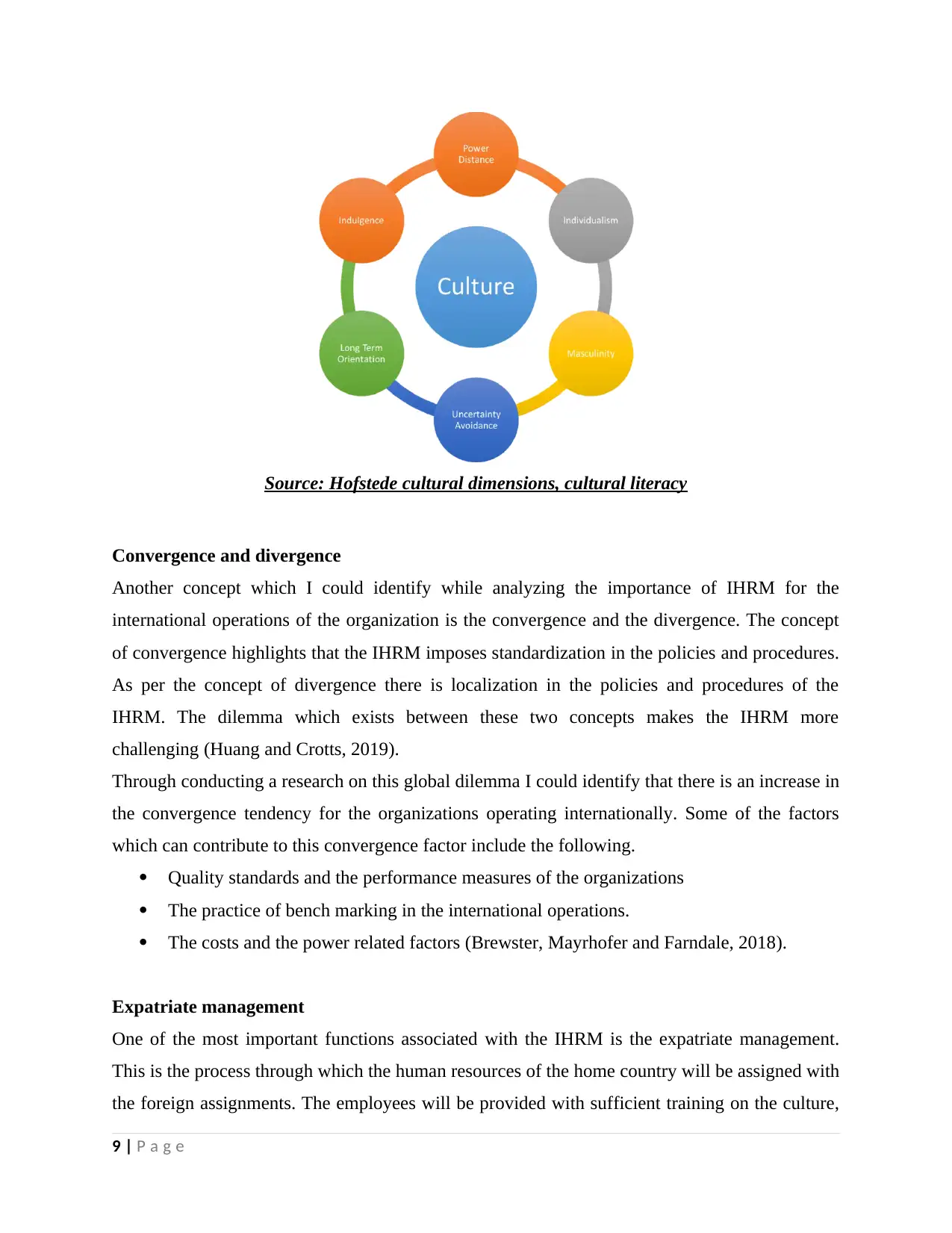
Source: Hofstede cultural dimensions, cultural literacy
Convergence and divergence
Another concept which I could identify while analyzing the importance of IHRM for the
international operations of the organization is the convergence and the divergence. The concept
of convergence highlights that the IHRM imposes standardization in the policies and procedures.
As per the concept of divergence there is localization in the policies and procedures of the
IHRM. The dilemma which exists between these two concepts makes the IHRM more
challenging (Huang and Crotts, 2019).
Through conducting a research on this global dilemma I could identify that there is an increase in
the convergence tendency for the organizations operating internationally. Some of the factors
which can contribute to this convergence factor include the following.
Quality standards and the performance measures of the organizations
The practice of bench marking in the international operations.
The costs and the power related factors (Brewster, Mayrhofer and Farndale, 2018).
Expatriate management
One of the most important functions associated with the IHRM is the expatriate management.
This is the process through which the human resources of the home country will be assigned with
the foreign assignments. The employees will be provided with sufficient training on the culture,
9 | P a g e
Convergence and divergence
Another concept which I could identify while analyzing the importance of IHRM for the
international operations of the organization is the convergence and the divergence. The concept
of convergence highlights that the IHRM imposes standardization in the policies and procedures.
As per the concept of divergence there is localization in the policies and procedures of the
IHRM. The dilemma which exists between these two concepts makes the IHRM more
challenging (Huang and Crotts, 2019).
Through conducting a research on this global dilemma I could identify that there is an increase in
the convergence tendency for the organizations operating internationally. Some of the factors
which can contribute to this convergence factor include the following.
Quality standards and the performance measures of the organizations
The practice of bench marking in the international operations.
The costs and the power related factors (Brewster, Mayrhofer and Farndale, 2018).
Expatriate management
One of the most important functions associated with the IHRM is the expatriate management.
This is the process through which the human resources of the home country will be assigned with
the foreign assignments. The employees will be provided with sufficient training on the culture,
9 | P a g e
⊘ This is a preview!⊘
Do you want full access?
Subscribe today to unlock all pages.

Trusted by 1+ million students worldwide
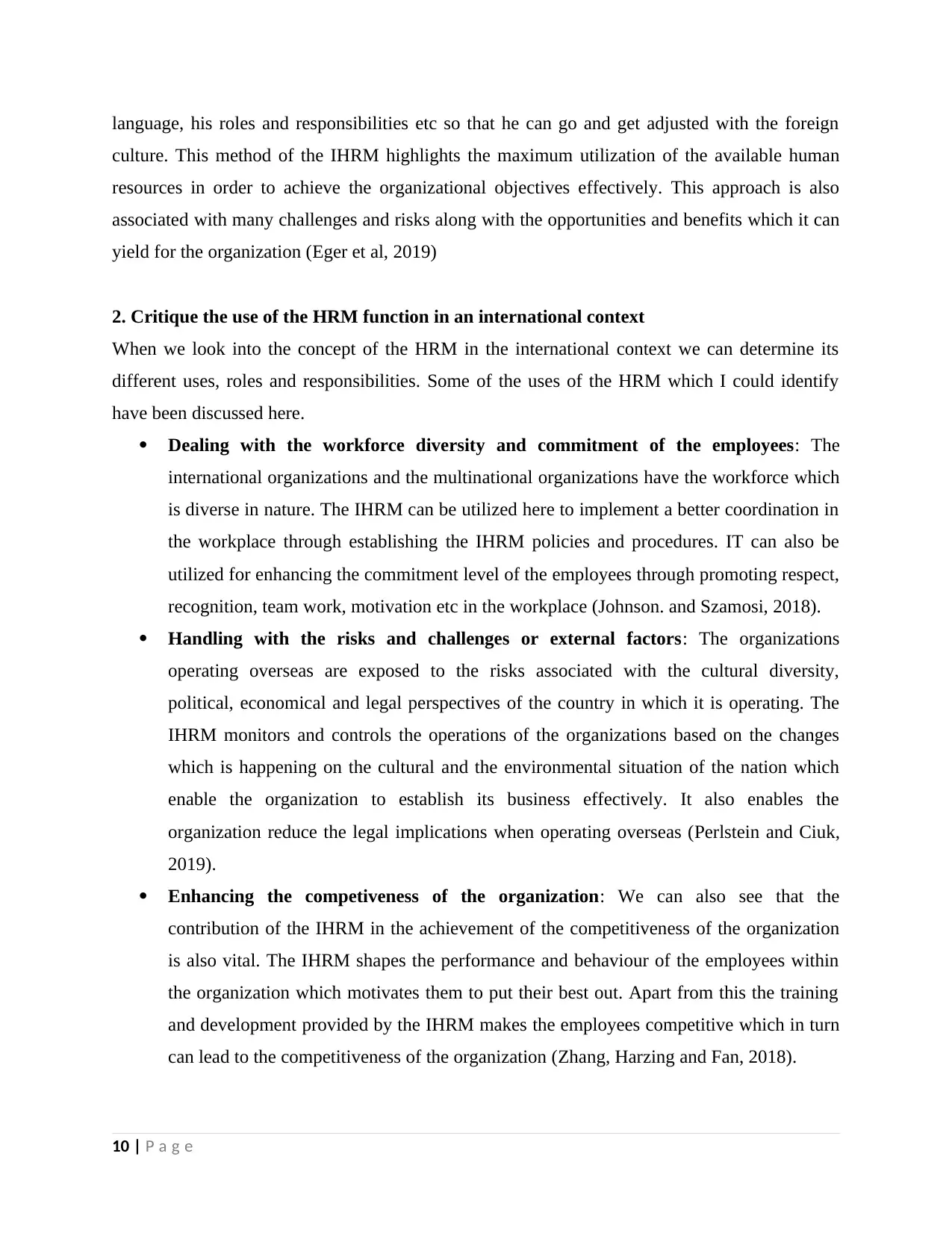
language, his roles and responsibilities etc so that he can go and get adjusted with the foreign
culture. This method of the IHRM highlights the maximum utilization of the available human
resources in order to achieve the organizational objectives effectively. This approach is also
associated with many challenges and risks along with the opportunities and benefits which it can
yield for the organization (Eger et al, 2019)
2. Critique the use of the HRM function in an international context
When we look into the concept of the HRM in the international context we can determine its
different uses, roles and responsibilities. Some of the uses of the HRM which I could identify
have been discussed here.
Dealing with the workforce diversity and commitment of the employees: The
international organizations and the multinational organizations have the workforce which
is diverse in nature. The IHRM can be utilized here to implement a better coordination in
the workplace through establishing the IHRM policies and procedures. IT can also be
utilized for enhancing the commitment level of the employees through promoting respect,
recognition, team work, motivation etc in the workplace (Johnson. and Szamosi, 2018).
Handling with the risks and challenges or external factors: The organizations
operating overseas are exposed to the risks associated with the cultural diversity,
political, economical and legal perspectives of the country in which it is operating. The
IHRM monitors and controls the operations of the organizations based on the changes
which is happening on the cultural and the environmental situation of the nation which
enable the organization to establish its business effectively. It also enables the
organization reduce the legal implications when operating overseas (Perlstein and Ciuk,
2019).
Enhancing the competiveness of the organization: We can also see that the
contribution of the IHRM in the achievement of the competitiveness of the organization
is also vital. The IHRM shapes the performance and behaviour of the employees within
the organization which motivates them to put their best out. Apart from this the training
and development provided by the IHRM makes the employees competitive which in turn
can lead to the competitiveness of the organization (Zhang, Harzing and Fan, 2018).
10 | P a g e
culture. This method of the IHRM highlights the maximum utilization of the available human
resources in order to achieve the organizational objectives effectively. This approach is also
associated with many challenges and risks along with the opportunities and benefits which it can
yield for the organization (Eger et al, 2019)
2. Critique the use of the HRM function in an international context
When we look into the concept of the HRM in the international context we can determine its
different uses, roles and responsibilities. Some of the uses of the HRM which I could identify
have been discussed here.
Dealing with the workforce diversity and commitment of the employees: The
international organizations and the multinational organizations have the workforce which
is diverse in nature. The IHRM can be utilized here to implement a better coordination in
the workplace through establishing the IHRM policies and procedures. IT can also be
utilized for enhancing the commitment level of the employees through promoting respect,
recognition, team work, motivation etc in the workplace (Johnson. and Szamosi, 2018).
Handling with the risks and challenges or external factors: The organizations
operating overseas are exposed to the risks associated with the cultural diversity,
political, economical and legal perspectives of the country in which it is operating. The
IHRM monitors and controls the operations of the organizations based on the changes
which is happening on the cultural and the environmental situation of the nation which
enable the organization to establish its business effectively. It also enables the
organization reduce the legal implications when operating overseas (Perlstein and Ciuk,
2019).
Enhancing the competiveness of the organization: We can also see that the
contribution of the IHRM in the achievement of the competitiveness of the organization
is also vital. The IHRM shapes the performance and behaviour of the employees within
the organization which motivates them to put their best out. Apart from this the training
and development provided by the IHRM makes the employees competitive which in turn
can lead to the competitiveness of the organization (Zhang, Harzing and Fan, 2018).
10 | P a g e
Paraphrase This Document
Need a fresh take? Get an instant paraphrase of this document with our AI Paraphraser
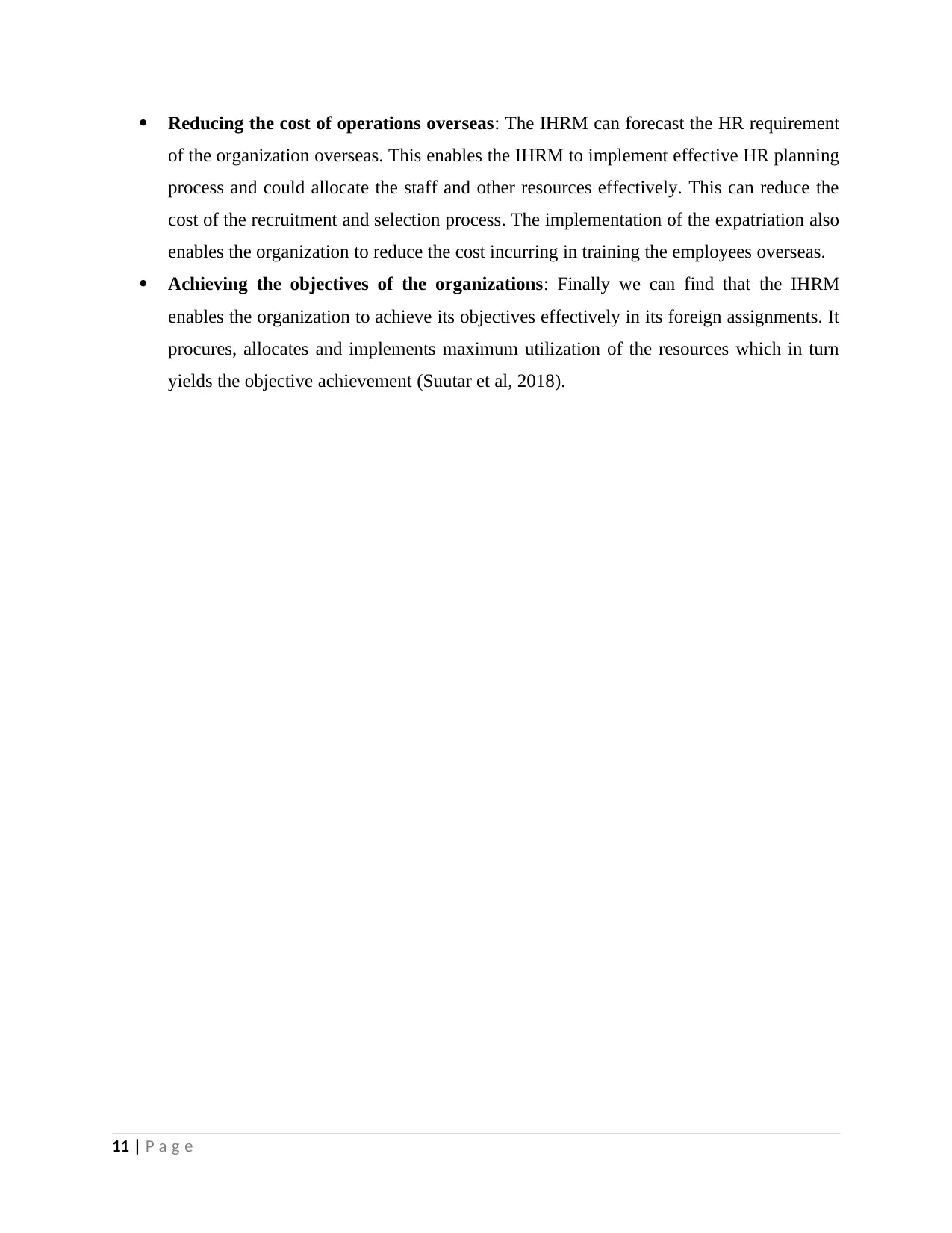
Reducing the cost of operations overseas: The IHRM can forecast the HR requirement
of the organization overseas. This enables the IHRM to implement effective HR planning
process and could allocate the staff and other resources effectively. This can reduce the
cost of the recruitment and selection process. The implementation of the expatriation also
enables the organization to reduce the cost incurring in training the employees overseas.
Achieving the objectives of the organizations: Finally we can find that the IHRM
enables the organization to achieve its objectives effectively in its foreign assignments. It
procures, allocates and implements maximum utilization of the resources which in turn
yields the objective achievement (Suutar et al, 2018).
11 | P a g e
of the organization overseas. This enables the IHRM to implement effective HR planning
process and could allocate the staff and other resources effectively. This can reduce the
cost of the recruitment and selection process. The implementation of the expatriation also
enables the organization to reduce the cost incurring in training the employees overseas.
Achieving the objectives of the organizations: Finally we can find that the IHRM
enables the organization to achieve its objectives effectively in its foreign assignments. It
procures, allocates and implements maximum utilization of the resources which in turn
yields the objective achievement (Suutar et al, 2018).
11 | P a g e
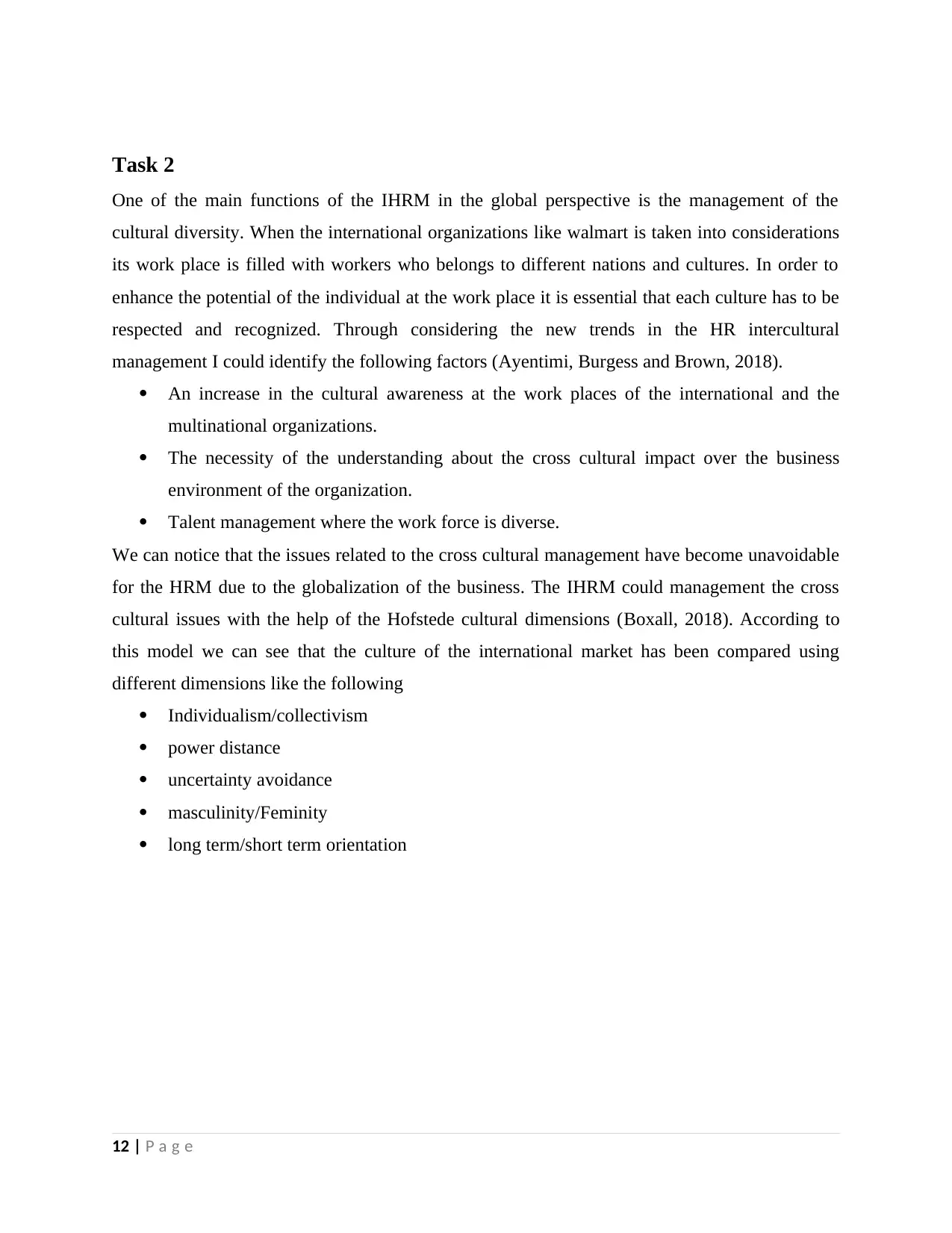
Task 2
One of the main functions of the IHRM in the global perspective is the management of the
cultural diversity. When the international organizations like walmart is taken into considerations
its work place is filled with workers who belongs to different nations and cultures. In order to
enhance the potential of the individual at the work place it is essential that each culture has to be
respected and recognized. Through considering the new trends in the HR intercultural
management I could identify the following factors (Ayentimi, Burgess and Brown, 2018).
An increase in the cultural awareness at the work places of the international and the
multinational organizations.
The necessity of the understanding about the cross cultural impact over the business
environment of the organization.
Talent management where the work force is diverse.
We can notice that the issues related to the cross cultural management have become unavoidable
for the HRM due to the globalization of the business. The IHRM could management the cross
cultural issues with the help of the Hofstede cultural dimensions (Boxall, 2018). According to
this model we can see that the culture of the international market has been compared using
different dimensions like the following
Individualism/collectivism
power distance
uncertainty avoidance
masculinity/Feminity
long term/short term orientation
12 | P a g e
One of the main functions of the IHRM in the global perspective is the management of the
cultural diversity. When the international organizations like walmart is taken into considerations
its work place is filled with workers who belongs to different nations and cultures. In order to
enhance the potential of the individual at the work place it is essential that each culture has to be
respected and recognized. Through considering the new trends in the HR intercultural
management I could identify the following factors (Ayentimi, Burgess and Brown, 2018).
An increase in the cultural awareness at the work places of the international and the
multinational organizations.
The necessity of the understanding about the cross cultural impact over the business
environment of the organization.
Talent management where the work force is diverse.
We can notice that the issues related to the cross cultural management have become unavoidable
for the HRM due to the globalization of the business. The IHRM could management the cross
cultural issues with the help of the Hofstede cultural dimensions (Boxall, 2018). According to
this model we can see that the culture of the international market has been compared using
different dimensions like the following
Individualism/collectivism
power distance
uncertainty avoidance
masculinity/Feminity
long term/short term orientation
12 | P a g e
⊘ This is a preview!⊘
Do you want full access?
Subscribe today to unlock all pages.

Trusted by 1+ million students worldwide
1 out of 20
Related Documents
Your All-in-One AI-Powered Toolkit for Academic Success.
+13062052269
info@desklib.com
Available 24*7 on WhatsApp / Email
![[object Object]](/_next/static/media/star-bottom.7253800d.svg)
Unlock your academic potential
Copyright © 2020–2025 A2Z Services. All Rights Reserved. Developed and managed by ZUCOL.




